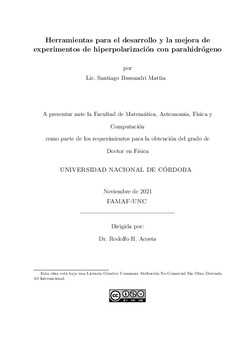| dc.contributor.advisor | Acosta, Rodolfo Héctor | |
| dc.contributor.author | Bussandri Mattia, Santiago | |
| dc.date.accessioned | 2021-12-17T14:08:43Z | |
| dc.date.available | 2021-12-17T14:08:43Z | |
| dc.date.issued | 2021 | |
| dc.identifier.uri | http://hdl.handle.net/11086/22048 | |
| dc.description | Tesis (Doctor en Física)--Universidad Nacional de Córdoba. Facultad de Matemática, Astronomía, Física y Computación, 2021. | es |
| dc.description.abstract | La principal característica del espectro adquirido al mismo campo magnético donde se produce una hidrogenación de a pares con gas parahidrógeno es la aparición de picos antifase, los cuales son particularmente sensibles al ensanchamiento de las líneas. Una manera simple de superar este impedimento consiste en adquirir la señal con un tren de pulsos de refocalización en lugar de un solo pulso de radiofrecuencia (r.f.). En esta tesis se presentarán distintos ejemplos donde esta adquisición multipulso, denominada PhD-PHIP, muestra su potencialidad en mejorar la información relacionada con espines hiperpolarizados mejorando la resolución y separando las señales térmicas de las hiperpolarizadas en el espectro. Primero, se presentará un estudio detallado de diferentes esquemas de fase en los pulsos de refocalización para la adquisición de espectros con el mínimo de errores, en el ancho espectral de interés definido por un filtro digital. Luego, se estudiará la difusión en una muestra hiperpolarizada extremadamente diluida usando una configuración especial de tubos de Teflón y un apropiado flujo de gas. Se aplicará la secuencia PhD-PHIP como un bloque de detección para separar las señales térmicas de las hiperpolarizadas. Finalmente, la presencia de una gran cantidad de moléculas no hidrogenadas dentro de la muestra puede disminuir la intensidad de la señal PHIP. En este sentido, la secuencia denominada OPSY (Only Parahydrogen SpectroscopY), utiliza un par de pulsos de gradientes de campo magnético para filtrar las señales térmicas, limpiando el espectro PHIP, pero manteniendo su carácter de antifase. Por esto en primer lugar, se aplicará la secuencia OPSY, filtrando las señales térmicamente polarizadas, para luego adquirir con la alta resolución que proporciona PhD-PHIP. En segundo lugar, se logrará el mismo resultado, pero reemplazando en el bloque de filtrado los gradientes de campo magnético estático con campos de radiofrecuencia variables linealmente en el espacio. | es |
| dc.description.abstract | The main characteristic of the spectrum acquired at the same high magnetic field at which a pairwise hydrogenation with parahydrogen gas is performed, is the appearance of anti-phase multiplets. This particular shape of the peaks is sensitive to line broadening. A simple way to overcome this impediment consists in acquiring the signal with a train of refocusing pulses instead of single radiofrequency (r.f.) pulse. In this thesis, we present several examples where this multipulse acquisition, denominated PhD-PHIP, displays its potentiality in improving the information related to hyperpolarized spins by enhancing the resolution and separating thermally induced signals from hyperpolarized ones in the spectrum. First, we present a detailed study of different phase schemes to determine the best alternative for the acquisition of spectra with the errors maintained to the minimum, in the frequency’s region of interest defined by a proper digital filter. Then, we study the diffusion coefficient of an extremely diluted hyperpolarized sample using a special configuration using Teflon tubes and the appropriate flow of gas. We apply the PhD-PHIP sequence as a detection block to separate thermal signals from hyperpolarized ones. Finally, the presence of a large number of non-hydrogenated molecules within the sample can decrease the intensity of the PHIP signal. In this sense, the sequence named OPSY (Only Parahydrogen SpectroscopY) was introduced recently, using a pair of pulses of magnetic field gradients to filter the signals that come from thermally polarized protons and therefore cleaning the PHIP spectrum but keeping it anti-phase character. So first the strategy of filtering the thermally polarized signals with the OPSY sequence and acquiring them with the high resolution provided by PhD-PHIP is applied. Second, the idea of achieving the same result is presented, but replacing the static magnetic field gradients with linearly varying radiofrequency fields in space in the filtering block. | en |
| dc.language.iso | spa | es |
| dc.rights | Attribution-NonCommercial-NoDerivatives 4.0 Internacional | * |
| dc.rights.uri | http://creativecommons.org/licenses/by-nc-nd/4.0/ | * |
| dc.subject | Hiperpolarización | es |
| dc.subject | Espectroscopía -J | es |
| dc.subject | RMN | es |
| dc.subject | Nuclear magnetic resonance and relaxation | en |
| dc.subject | Spin dynamics | en |
| dc.subject | Spin echoes | en |
| dc.subject | Pulse sequences in NMR | en |
| dc.subject | Nuclear magnetic resonance | en |
| dc.subject | NMR | en |
| dc.title | Herramientas para el desarrollo y la mejora de experimentos de hiperpolarización con parahidrógeno | es |
| dc.type | doctoralThesis | es |
| dc.description.fil | Fil: Bussandri Mattia, Santiago. Universidad Nacional de Córdoba. Facultad de Matemática, Astronomía, Física y Computación; Argentina. | es |





